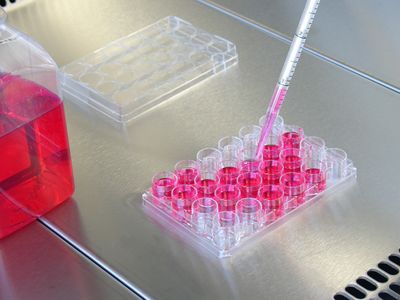ABOVE: Humans consume a bewildering quantity of microplastics, which affect the gut’s microbiota. © istock.com, thexfilephoto
The earth’s oceans contain vortexes of plastic trash. These slow-swirling patches of suspended debris span a collective area of millions of square kilometers.1 Polyethylene, which is commonly used for medical, cosmetic, food wrapping, and industrial purposes, is the most prevalent marine plastic contaminant.2 Much of this waste is microplastic (MP) particles, which disrupt the delicate balance of marine and terrestrial ecosystems from the tiniest microorganisms all the way up the food chain.
Each week, humans consume up to five grams of MPs3—the equivalent of five paper clips—through various routes, turning the human body into its own reservoir of MP waste.4 Researchers discovered MPs flowing through human blood5 and islands of MPs in various organs, including the liver, kidney, spleen, lungs, and placenta. 6,7,8,9,10 Humans also excrete MPs in their stool.11
The gastrointestinal (GI) tract is the most common entryway for MPs, and is a gateway to more widespread systemic dysfunction. In a recent study published in The Journal of Hazardous Materials, researchers used an in vitro artificial colon model plus intestinal cell cultures to examine how MP exposure influences the gut microbiota and intestinal barrier.12
“Clinical studies are limited by obvious ethical constraints. In vitro human colonic models are valuable tools allowing to maintain a complex and metabolically active human gut microbiota for several weeks under physiologically relevant conditions,” said Muriel Mercier-Bonin, research director at the French National Institute for Agriculture, Food, and Environment (INRAE) and coauthor of the study.

Mercier-Bonin and her team used an adult human colon model—a bioreactor system that mimics the microbiota niches of the human colon—to study how repeated exposure to polyethylene microspheres affects microbial communities and their metabolic activities. Fecal microbiota samples from healthy adult donors were fermented in this model system and exposed to MPs daily for two weeks. Mercier-Bonin and her team examined how the diversity and activity of these microbial communities changed. They also added microbiota samples from the bioreactor to cell cultures of donor intestinal cells obtained from cell banks to study whether MP exposure disrupts the intestinal barrier.
The researchers found that ongoing MP exposure decreased beneficial gut bacteria and increased pathogenic species, along with their production of potentially harmful metabolites associated with gut dysregulation. These metabolites did not significantly disrupt the cultured gut lining, but the healthy adult microbiota samples used in this study may differ from those of individuals with underlying GI disorders, or those from people who are more vulnerable to MP exposure, such as infants.13,14 For example, other researchers reported a correlation between inflammatory bowel disease severity and fecal MP concentrations.15
According to Ian Carroll, a molecular microbiologist and assistant professor in the Department of Nutrition at the University of North Carolina who was not involved with the study, the intestinal microbiota is central to health. Any environmental or lifestyle factor that shifts the balance of the gut microbiota towards pathogenic species can trigger or exacerbate disease. “You have to think about it in the context of disease. Studies like this are great starting points. They’re cross sectional and will tell you what has happened, but what is the consequence? Does [exposure] cause subsequent disease? We don’t know the mechanisms and a lot more research needs to be done,” said Carroll.
As researchers continue to track the ebb and flow of gut microbial communities, the flotsam of marine plastic waste embeds itself further into environmental niches and the food chain. In the end, human GI jetsam may hold the key to unravelling how MP exposure shapes digestive ecosystems and overall health.
References
- S.R. Mir Salimi et al., “The five ocean garbage patches,” https://storymaps.arcgis.com/
- G. Erni-Cassola et al., “Distribution of plastic polymer types in the marine environment: A meta-analysis,” J Hazard Mater, 369:691-98, 2019.
- K. Senathirajah et al., “Estimation of the mass of microplastics ingested–A pivotal first step towards human health risk assessment,” J Hazard Mater, 404:124004, 2021.
- P. Wu et al., “Absorption, distribution, metabolism, excretion and toxicity of microplastics in the human body and health implications,” J Hazar Mater, 437:129361, 2022.
- H.A. Leslie et al., “Discovery and quantification of plastic particle pollution in human blood,” Environ Int, 163: 107199, 2022.
- L.C. Jenner et al., “Detection of microplastics in human lung tissue using µFTIR spectroscopy,” Sci Total Environ, 831:154907, 2022.
- T. Horvatits et al., “Microplastics detected in cirrhotic liver tissue,” EBioMedicine, 82:104147, 2022.
- A. Ragusa et al., “Plasticenta: First evidence of microplastics in human placenta,” Environ Int, 146:106274, 2021.
- S. Liu et al., “The association between microplastics and microbiota in placentas and meconium: The first evidence in humans,” Environ Sci Technol, doi: 10.1021/acs.est.2c04706, Epub ahead of print, 2022.
- American Chemical Society, “Micro- and nanoplastics detectable in human tissues,” Science Daily, 2020, www.sciencedaily.com/releases/2020/08/200817104325.htm, Accessed 22 February 2023.
- P. Schwabl et al., “Detection of various microplastics in human stool: a prospective case series,” Ann Intern Med, 171(7):453-57, 2019.
- E. Fournier et al., “Microplastics: What happens in the human digestive tract? First evidences in adults using in vitro gut models,” J Hazard Mater, 442:130010, 2023.
- S. Quaglia, “More microplastics in babies’ faeces than in adults’ – study,” The Guardian, 2021, https://www.theguardian.com/science/2021/sep/22/more-microplastics-in-babies-faeces-than-in-adults-study, Accessed 22 February 2023.
- S. Liu et al., “Detection of various microplastics in placentas, meconium, infant feces, breastmilk and infant formula: A pilot prospective study,” Sci Total Environ, 854:158699, 2022.
- Z. Yan et al., “Analysis of microplastics in human feces reveals a correlation between fecal microplastics and inflammatory bowel disease status,” Environ Sci Technol, 56(1):414-21, 2022.




